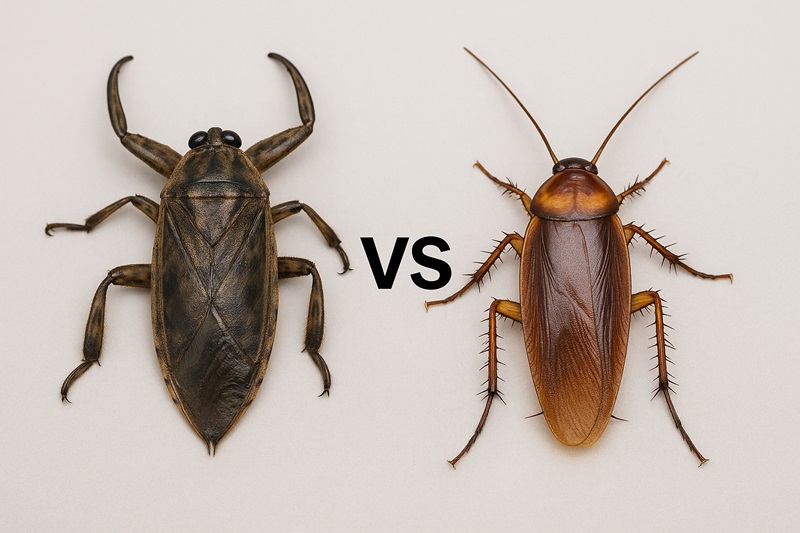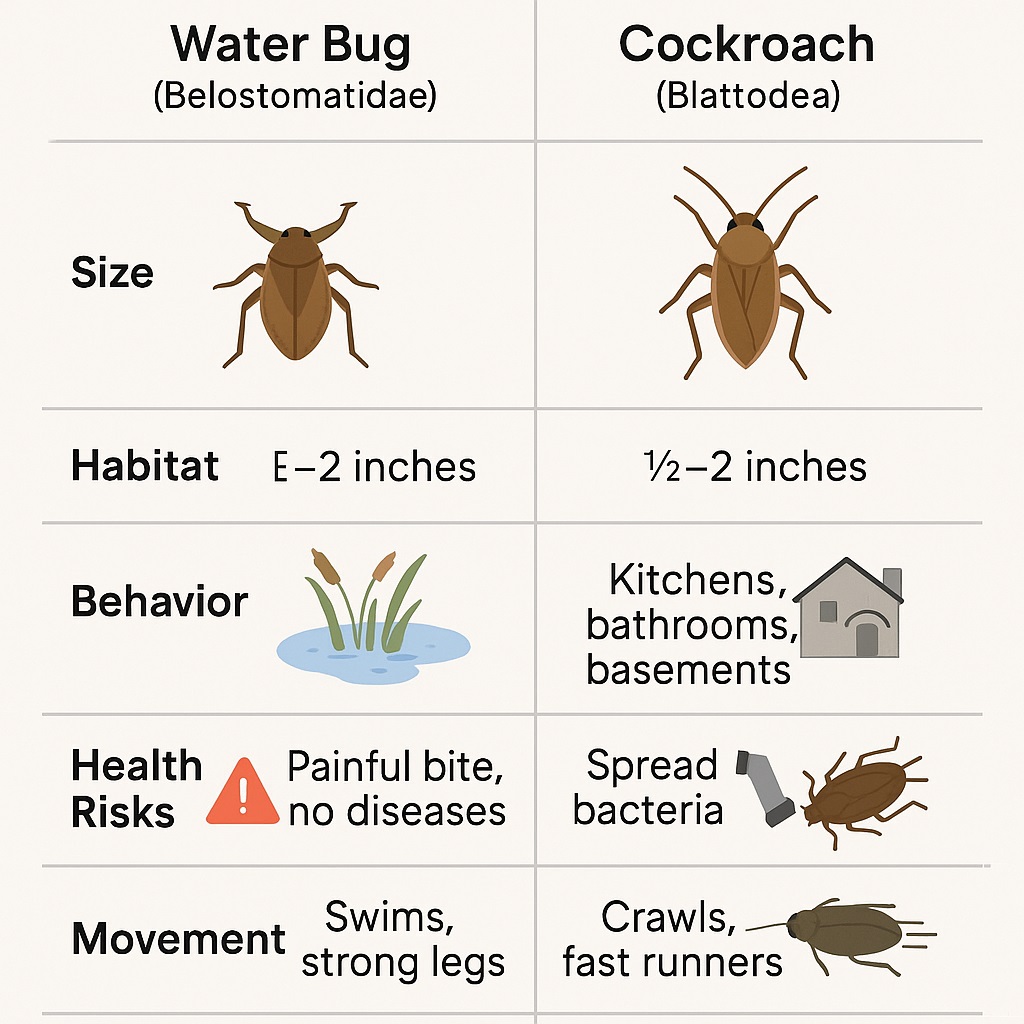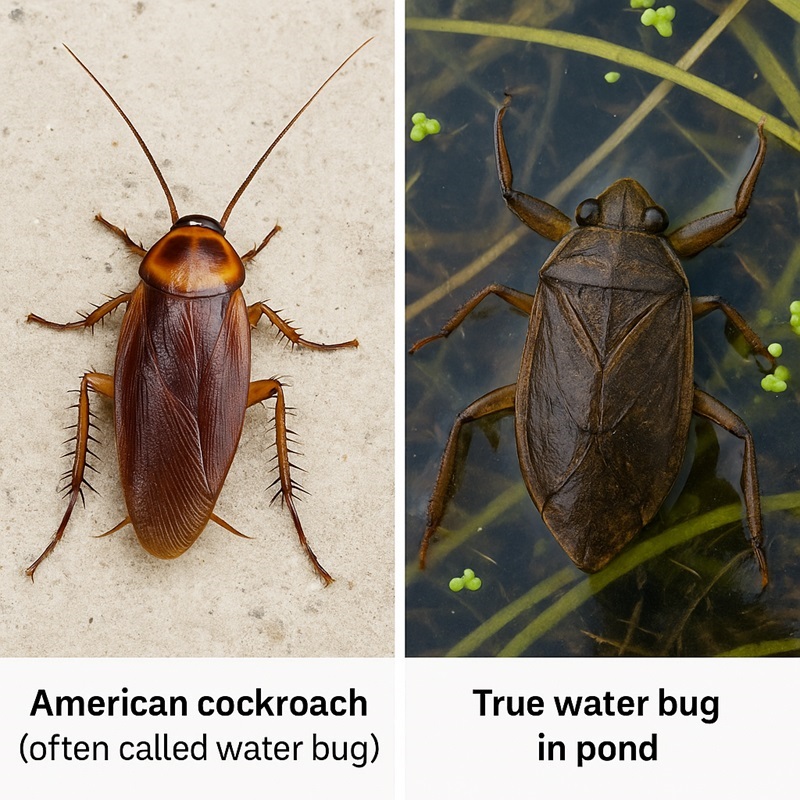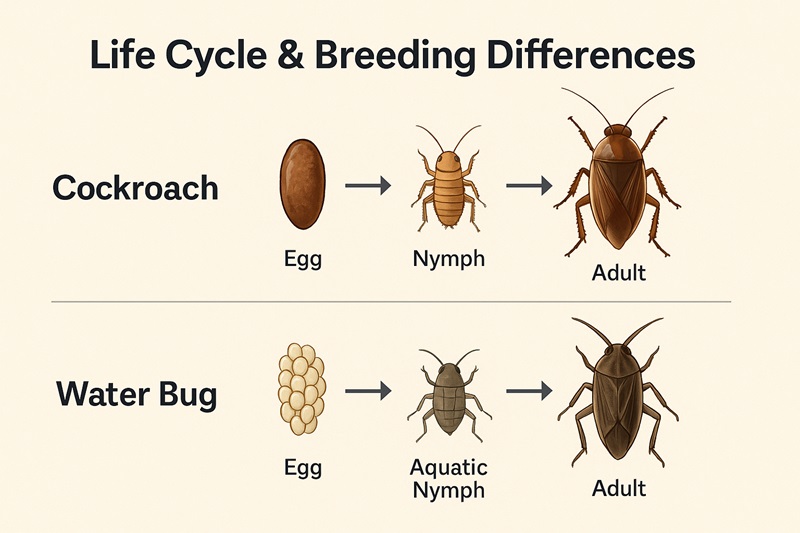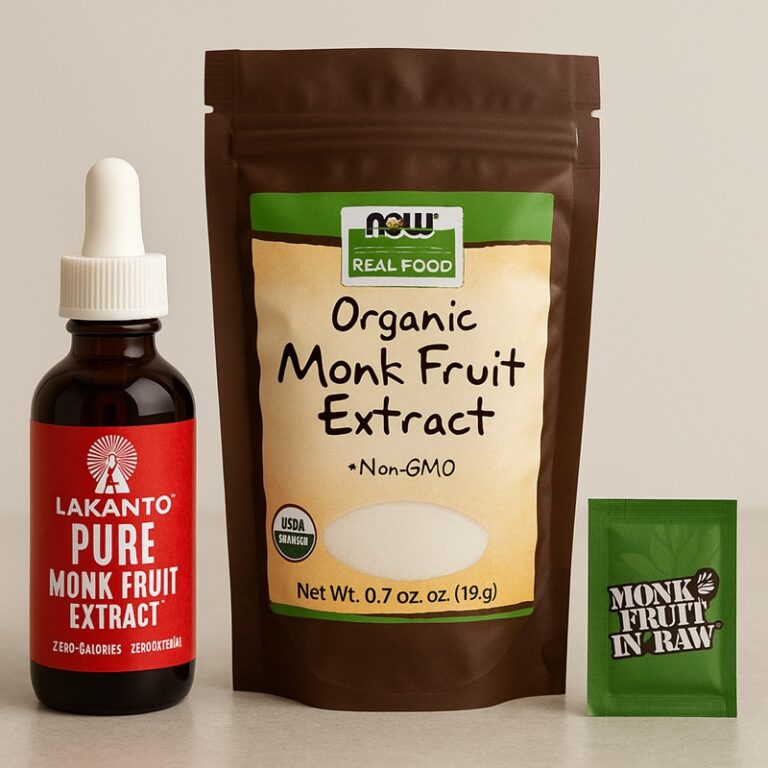Quick Answer — How to Tell Them Apart
At first glance, a water bug and a cockroach look alike. Both are flat, brownish, and unsettling when spotted in your kitchen or near your porch light. But the similarity is misleading. A water bug is an aquatic insect that prefers lakes and ponds, while a cockroach is a resilient household pest that thrives in human environments.
If you see a large, dark insect crawling in your bathroom or running across the floor when the lights switch on, it is almost always a cockroach. A true water bug almost never lives indoors.
At a Glance: Water Bug vs Cockroach
| Feature | Water Bug (Belostomatidae) | Cockroach (Blattodea) |
| Size | 1–2 inches (larger) | ½–2 inches |
| Habitat | Ponds, pools, drains | Kitchens, bathrooms, basements |
| Behavior | Bites when threatened, solitary | Scavengers, infest in groups |
| Health Risks | Painful bite, no diseases | Spread bacteria, trigger asthma |
| Movement | Swims, strong legs | Crawls, fast runners |
What Are Water Bugs?
Water bugs belong to the family Belostomatidae. They are sometimes called “giant water bugs” or “toe-biters” because of their size and painful bite. These insects are aquatic predators, living in ponds, slow-moving streams, and wetlands. They use their powerful front legs like pincers to grab prey, which may include fish, tadpoles, or other insects.
Unlike cockroaches, water bugs do not scavenge on household waste. They hunt. And while their bite is painful, they do not spread disease. They are also solitary, meaning they don’t form large indoor infestations.
What Are Cockroaches?
Cockroaches, on the other hand, are members of the order Blattodea. They are some of the most adaptable creatures on Earth, found on every continent except Antarctica. Common household species include the German cockroach, American cockroach, and Oriental cockroach.
Unlike water bugs, cockroaches are scavengers. They consume everything from crumbs to grease to cardboard glue. They hide in cracks and crevices, reproduce quickly, and can infest an entire home in a matter of weeks. Their resilience is what makes them such notorious pests.
Physical & Behavioral Differences
Appearance & Body Features
Water bugs are typically larger than cockroaches, often measuring over two inches long. They are oval, flat, and dark brown to black, with short antennae and broad, paddle-shaped legs designed for swimming.
Cockroaches are usually smaller—half an inch to two inches depending on the species. They have long antennae, spiny legs, and a more elongated body. Their wings lie flat across their backs, and while some species can fly short distances, they are primarily runners.
Movement & Habitat
Water bugs are strong swimmers. They live in natural water sources and are sometimes drawn to artificial lights at night, which is why they might be found under porch lamps in summer.
Cockroaches, in contrast, are fast crawlers. They thrive in kitchens, bathrooms, basements, and anywhere with warmth, moisture, and food scraps. Unlike water bugs, they actively seek out human environments.
Behavior & Diet
Water bugs are predators. They use piercing mouthparts to inject enzymes into prey, essentially liquefying it before consumption.
Cockroaches are scavengers. They eat almost anything organic—food crumbs, paper, cardboard, soap, even hair. Their ability to survive on little sustenance is one reason they are so difficult to eliminate.
Why People Confuse Them
The confusion arises because American cockroaches are sometimes nicknamed “water bugs.” This mislabeling dates back to when people commonly saw them in damp basements or near drains. But true water bugs rarely wander into homes.
Another reason for the mix-up is sheer size. American cockroaches are among the largest roach species, growing up to two inches long—the same size range as water bugs. For a startled homeowner, the difference may not be obvious.
Health Risks & Dangers
Water Bug Bites — Painful but Harmless
Water bugs can bite if handled, and the bite is intensely painful, earning them the nickname “toe-biters.” However, they are not venomous, nor do they spread bacteria or disease. Once the pain subsides, there are usually no lasting effects.
Cockroach Allergens & Contamination
Cockroaches pose a much greater health risk. According to the CDC, cockroach droppings, saliva, and shed skins contain allergens that can trigger asthma and allergies, especially in children. They also carry bacteria like E. coli and Salmonella, contaminating food and surfaces as they scuttle around.
For people with compromised immune systems or respiratory issues, an infestation can cause serious health complications. This is why identifying cockroaches early is so important.
Signs of Infestation
Water Bug Sightings
If you see a true water bug inside your house, it’s usually an accident. They are outdoor insects and do not establish colonies indoors. A lone sighting in summer may mean it was attracted to your porch light and wandered in.
Cockroach Infestation Indicators
Cockroach infestations are much easier to spot. Early signs include:
- Small, pepper-like droppings in cupboards or drawers.
- Egg cases (oothecae) stuck to walls or hidden in corners.
- A strong, musty odor that intensifies as the colony grows.
Unlike water bugs, cockroaches reproduce rapidly. A single female German cockroach can produce hundreds of offspring in a year.
Seasonal Patterns
Water bugs are most active in warm weather and often appear in summer near outdoor lights. Cockroaches, however, can survive year-round indoors. Infestations peak during hot, humid months but remain a problem even in winter in heated homes.
Regional Hotspots
- Water bugs are common in the Midwest and Southern U.S., where lakes and ponds are abundant.
Cockroaches thrive nationwide but are especially problematic in urban areas and warm states such as Florida, Texas, and California.
How to Remove & Control
DIY & Eco-Friendly Approaches
For water bugs, control is usually unnecessary beyond removing the stray intruder. For cockroaches, prevention and control require persistence:
- Seal cracks and crevices around the home.
- Store food in airtight containers.
- Eliminate moisture by fixing leaky pipes.
- Reduce clutter, especially cardboard and paper.
Eco-friendly options include sprinkling diatomaceous earth along baseboards, using citrus sprays, or setting sticky traps. These methods reduce populations without relying on heavy chemical use.
When to Call Pest Control
If you continue to see cockroaches despite cleaning and prevention, it’s time to call professionals. Pest control experts can apply targeted treatments and follow-up visits to eliminate colonies. In severe infestations, this is often the only reliable solution.
Eco-Friendly and Natural Control Options
Many homeowners want pest control without harsh chemicals. Eco-friendly approaches can be effective for both prevention and minor infestations:
- Diatomaceous earth: A natural powder that dehydrates cockroaches.
- Essential oils: Peppermint, eucalyptus, or tea tree oils can repel roaches.
- Sticky traps: Safe monitoring tools for early detection.
- For water bugs: Focus on eliminating standing water and sealing entry points — no chemicals needed.
These methods won’t always replace professional treatments for large infestations, but they provide safer, sustainable first steps.
Recommended Read: Kissing Bug vs Stink Bug
Which Infestation Is Harder to Control?
When it comes to long-term management, cockroach infestations are much harder to control than water bug encounters. The reason lies in how these two pests live and reproduce.
- Water Bugs:
Water bugs are usually accidental intruders. They don’t breed indoors and won’t establish colonies in your home. Once you eliminate the water source that attracted them — such as a clogged drain, leaky pipe, or swimming pool — the problem typically resolves. A water bug sighting often points to a moisture issue, not a true infestation. - Cockroaches:
Cockroaches are survival experts. A single female can produce hundreds of offspring in a year, quickly turning a few roaches into a full-blown infestation. They hide deep in cracks, walls, and appliances, making them difficult to reach with surface cleaning or sprays. To make matters worse, cockroaches have developed resistance to many common pesticides, meaning DIY efforts often fall short.
While water bugs may startle homeowners, they rarely become a chronic problem. Cockroaches, however, can establish thriving colonies indoors, spread rapidly, and require persistent control efforts — often with professional pest management.
Infestation Severity — Which Is Harder to Control?
Life Cycle & Breeding Differences
Water bugs lay eggs in aquatic environments and develop slowly. Because they do not live indoors, their presence rarely escalates into an infestation.
Cockroaches, however, breed rapidly. German cockroaches, in particular, are notorious for their explosive population growth. This rapid reproduction makes them far harder to eliminate once they gain a foothold in a home.
Prevention Tips
Preventing cockroach infestations means cutting off their three essentials: food, water, and shelter. Routine cleaning, proper food storage, and moisture control go a long way toward keeping them out.
Frequently Asked Questions
Are water bugs dangerous?
Not in the sense of disease. They bite, but the pain fades quickly.
Do cockroaches bite humans?
It’s rare, but in severe infestations, cockroaches may nibble on human skin, especially while sleeping.
Why do people call cockroaches water bugs?
The American cockroach is often nicknamed “water bug” because it thrives in damp areas like sewers and drains.
Can water bugs infest a house?
No. They cannot survive without access to natural water sources.
Cost Comparison — DIY vs Professional Treatments
The cost of dealing with cockroaches depends on severity. DIY methods like traps, sprays, or diatomaceous earth cost $20–$60. Professional pest control typically ranges from $150–$400 per visit, and heavy infestations may require multiple treatments.
With water bugs, there’s usually no cost involved—they rarely need professional control. Simply removing the insect or preventing entry by sealing gaps is enough.
Final Takeaway
Water bugs and cockroaches may look alike, but the differences are significant. Water bugs are aquatic hunters that pose little risk beyond a painful bite. Cockroaches are resilient pests that can compromise health, spread allergens, and infest homes quickly.
By learning the distinctions, homeowners can act appropriately: ignore or gently remove the occasional water bug, but treat cockroach sightings as a red flag requiring immediate action. Prevention, cleanliness, and—if needed—professional pest control remain the best strategies for a pest-free home.


